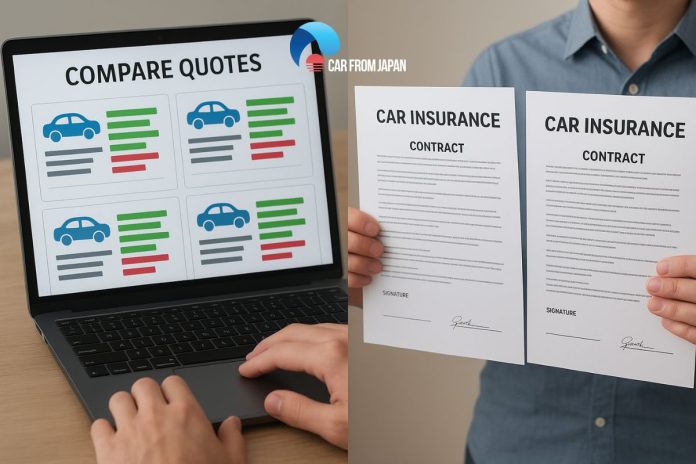Buying a new ride is exciting, but let’s be honest, the car insurance quote that follows can feel like a splash of cold water. In Canada, auto insurance is one of the biggest yearly expenses for drivers.
According to the Insurance Bureau of Canada (IBC), the average driver pays between $1,300–$2,000 annually, with Ontario holding some of the highest rates in the country.
However, you have more power over how much you pay than you realize. You don’t have to accept the first number you’re handed.
There are practical, proven ways, such as to compare the best quotes & rates instead of sticking with the first option you find, to bring your premium down without cutting corners on coverage.
Many drivers are surprised to see savings of hundreds, sometimes thousands, simply by shopping around.
Car insurance premiums can seem confusing, but the majority of the significant cost savings belong to a handful of categories.
From the vehicle you drive to how you handle your policy, here are reasonable steps to save money without sacrificing necessary coverage.
Compare and Shop Around Every Time You Renew
Most individuals remain with the same insurance company for a number of years, believing that loyalty rewards them with more favourable rates.
The truth is that insurance companies typically have their largest discounts available for newcomers.
Every time your policy is up for renewal, shop around. Many websites facilitate side-by-side multiple offers, and you will see clearly where the savings lie.
Even if you’re happy with your current provider, sharing a competitor’s lower quote can sometimes convince them to match or beat the rate.
Bundle Your Policies
If you have a home, condo, or even a rental, most insurers will discount when you bundle several policies with one carrier.
Bundling home and car insurance can reduce your premium by 10–25%. It also makes your life easier as you have fewer bills and providers to deal with.
Pick Your Car Carefully
Insurance prices aren’t solely up to you as a driver, your vehicle has a major influence. Cars with high repair prices, bad safety ratings, or a past history of theft usually cost more to insure.
When you’re shopping for your next vehicle, look up which cars are “insurance-friendly.”
Frequently, sedans and SUVs with robust safety features and modest repair prices are less expensive to insure than flashy sports cars or luxuries.

Raise Your Deductible
Your deductible is how much you pay yourself before insurance pays out after a claim. You can opt for a higher deductible (e.g., $1,000 vs. $500) and pay a lower monthly premium.
This is best if you’re a good driver and have plenty of savings to cover the increased deductible when you do need it.
Keep a Clean Driving Record
It sounds like a cliché, but not getting speeding tickets, DUIs, and accidents is one of the best methods to save money on insurance.
Insurers give safe drivers cheaper rates, and some even provide “accident-free” discounts after several years of incident-free driving.
Capitalize on Usage-Based Insurance
Several insurers now have telematics programs where you put a small device in your car or download an app that monitors your driving behaviour.
Responsible drivers who practice soft braking, daytime driving, and slow speeding tend to pay big discounts.
If you feel secure in your behaviour, this can be a good opportunity for you to show that you should have a lower rate.
Pay Yearly Rather Than Monthly
Most individuals prefer to pay monthly for the convenience, but insurers usually make you pay small fees for payment spreading.
If financially possible, paying the entire premium for the year upfront can earn you 5–10% each year.
Insurers do not necessarily promote every discount. Depending on your circumstances, you could be eligible for discounts based on.
- Being a good student
- Completing an approved driver safety course
- Being a member of some professional associations or alumni organizations
- Having your car equipped with state-of-the-art anti-theft devices
It doesn’t hurt to ask your agent what discounts you could be overlooking.
Think Carefully About Your Coverage Needs
While underinsurance is dangerous, too many drivers overinsure. Let’s say you have an old vehicle that isn’t worth much more than a few thousand dollars.
Collisions might not be worth the money because payoffs would not be high. You can instead concentrate on liability and comp coverage that offers more protection of your financial exposure.
This way, you’re not wasting money on coverage that doesn’t make sense for the value of your car.
Instead, you’re directing those funds toward policies that actually safeguard your finances and give you peace of mind where it really matters.
Work on Your Credit Score
In most provinces, it’s possible for insurers to use your credit score to calculate premiums.
The better your score, the greater your indicator of financial responsibility – and the lower your risk for insurers – and, ultimately, lower premiums for you.
Monitor your credit report regularly, pay bills on time, and keep down your debt to realize long-term savings.
Additionally, maintaining a healthy mix of credit accounts, limiting hard inquiries, and reviewing your report for errors can all help protect and improve your score.
By taking proactive steps, you not only reduce insurance costs but also strengthen your overall financial profile, giving you access to better rates and opportunities.

Final Thoughts
Car insurance doesn’t have to hurt your wallet. With smart decisions, from the vehicle you drive to the way you buy coverage, you can maintain affordability without losing protection.
Never forget to compare the top quotes & rates before you commit, as the right carrier can make a difference.
With a little effort up front, you’ll save more in the long run, freeing up money for the part of car ownership that’s fun: hitting the road.



